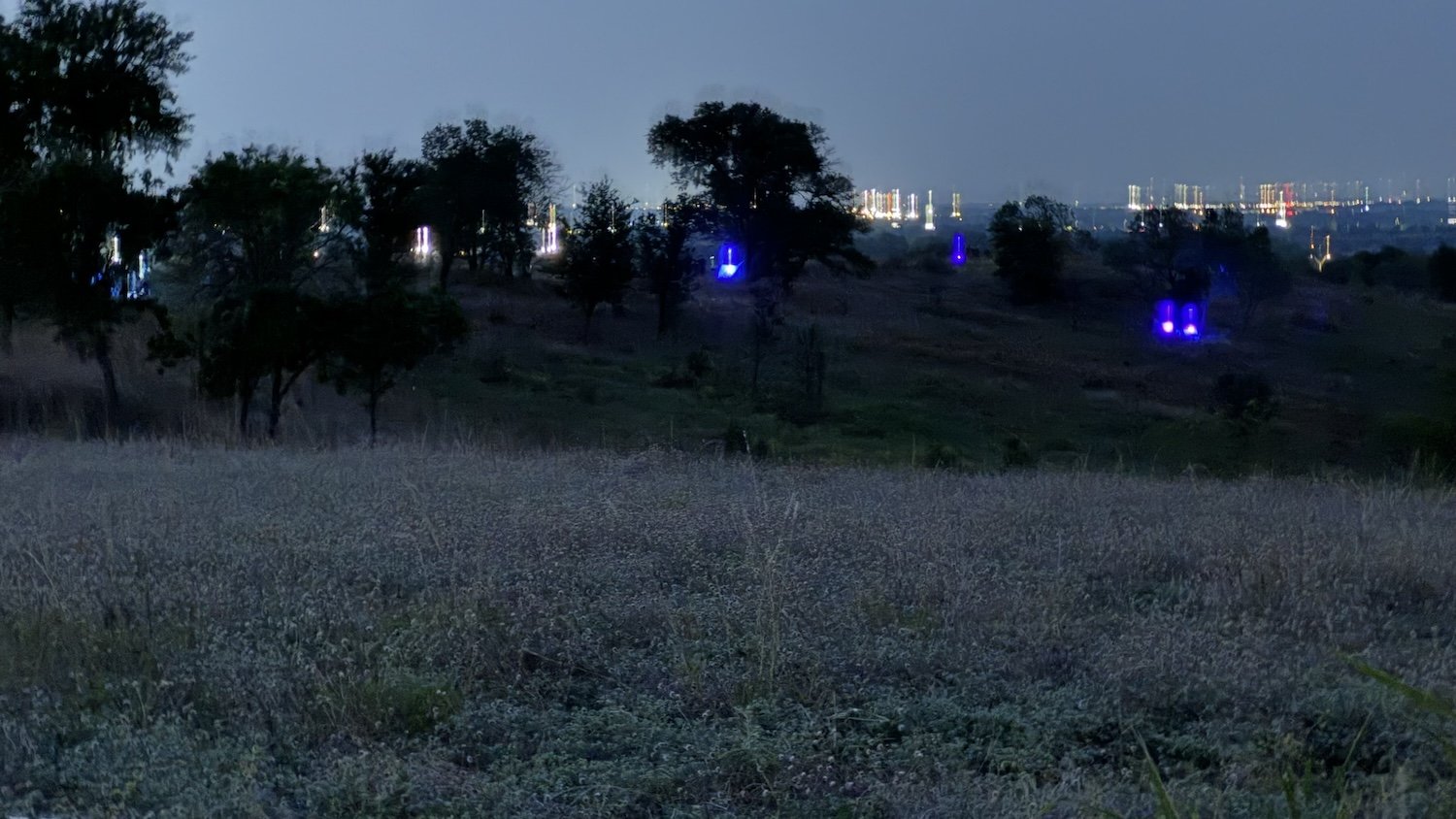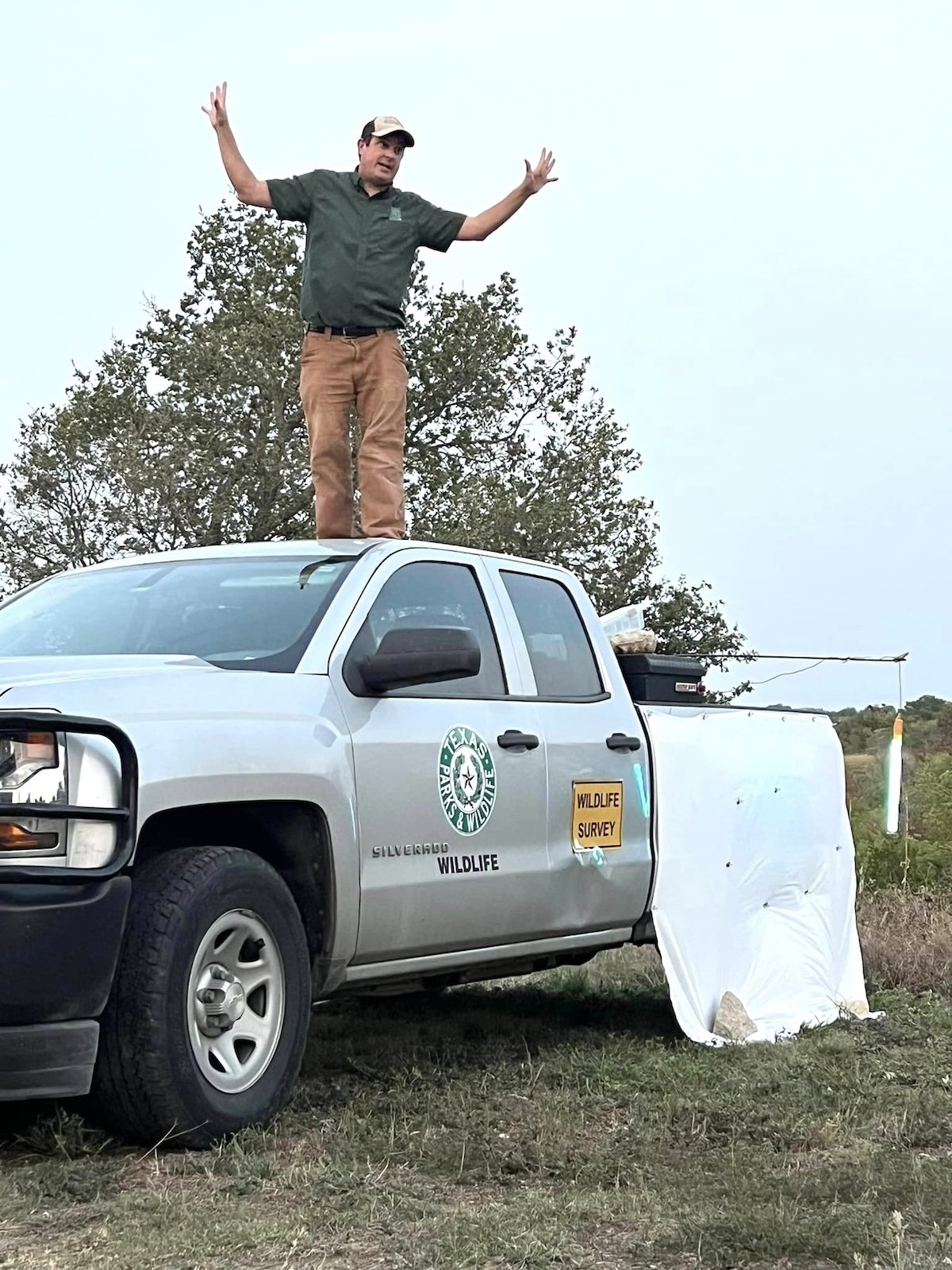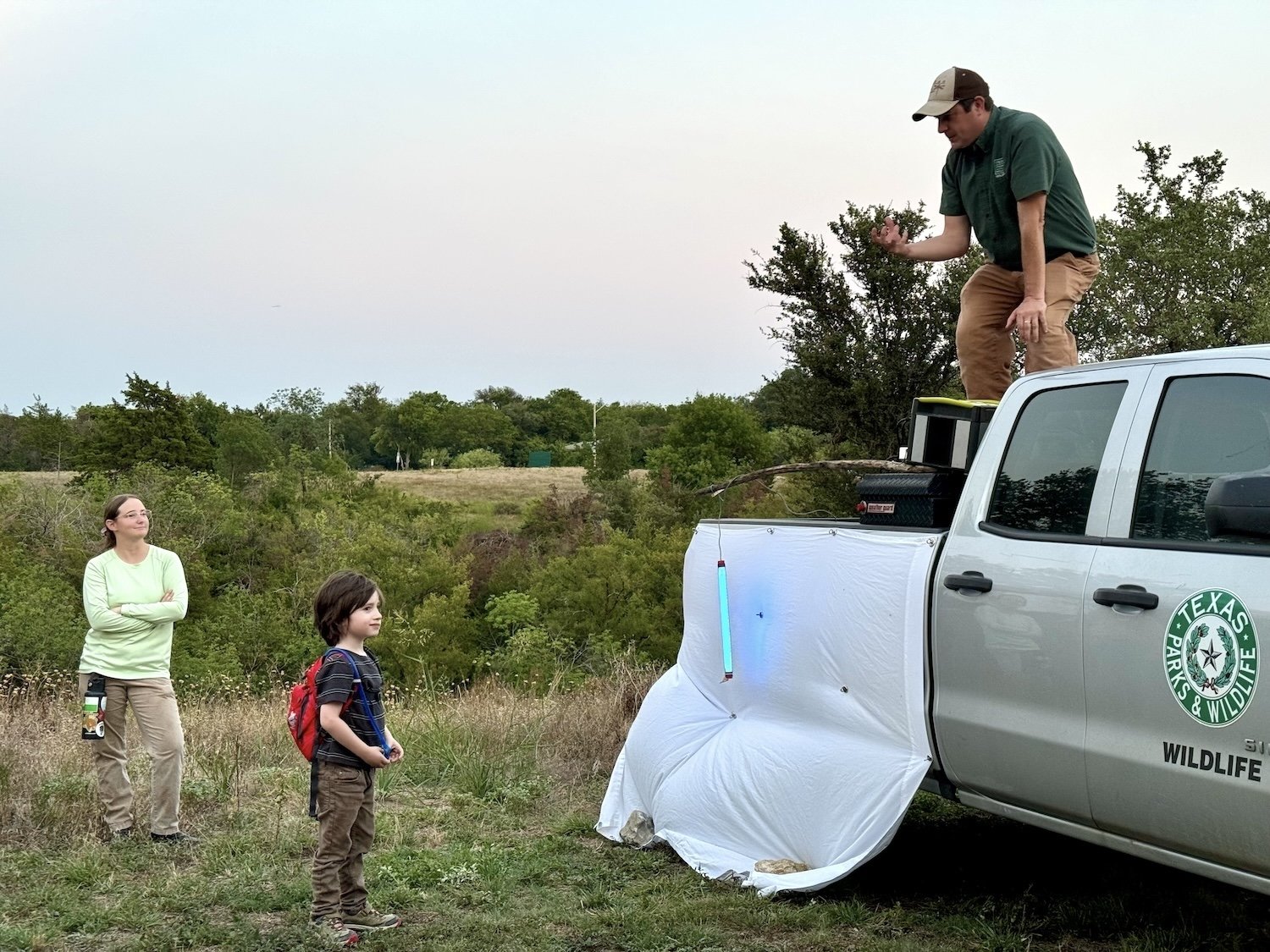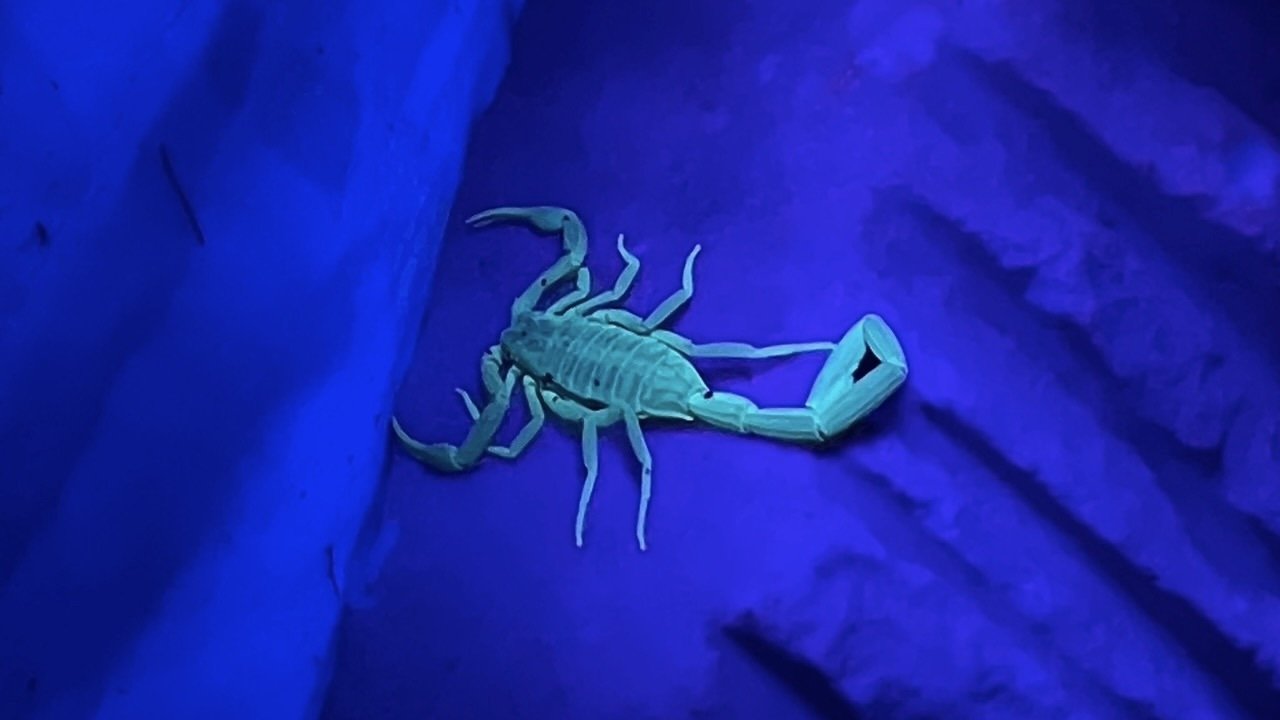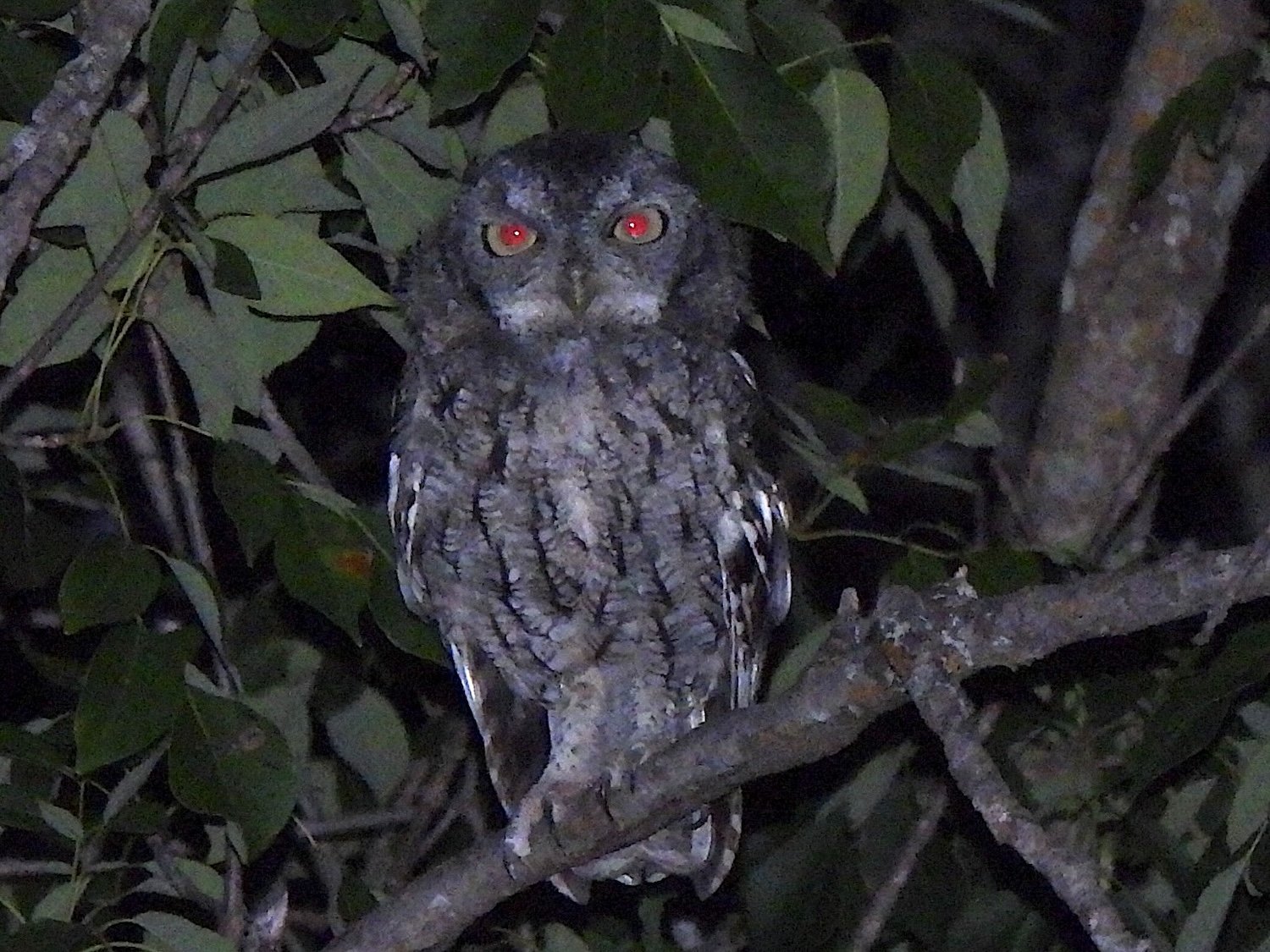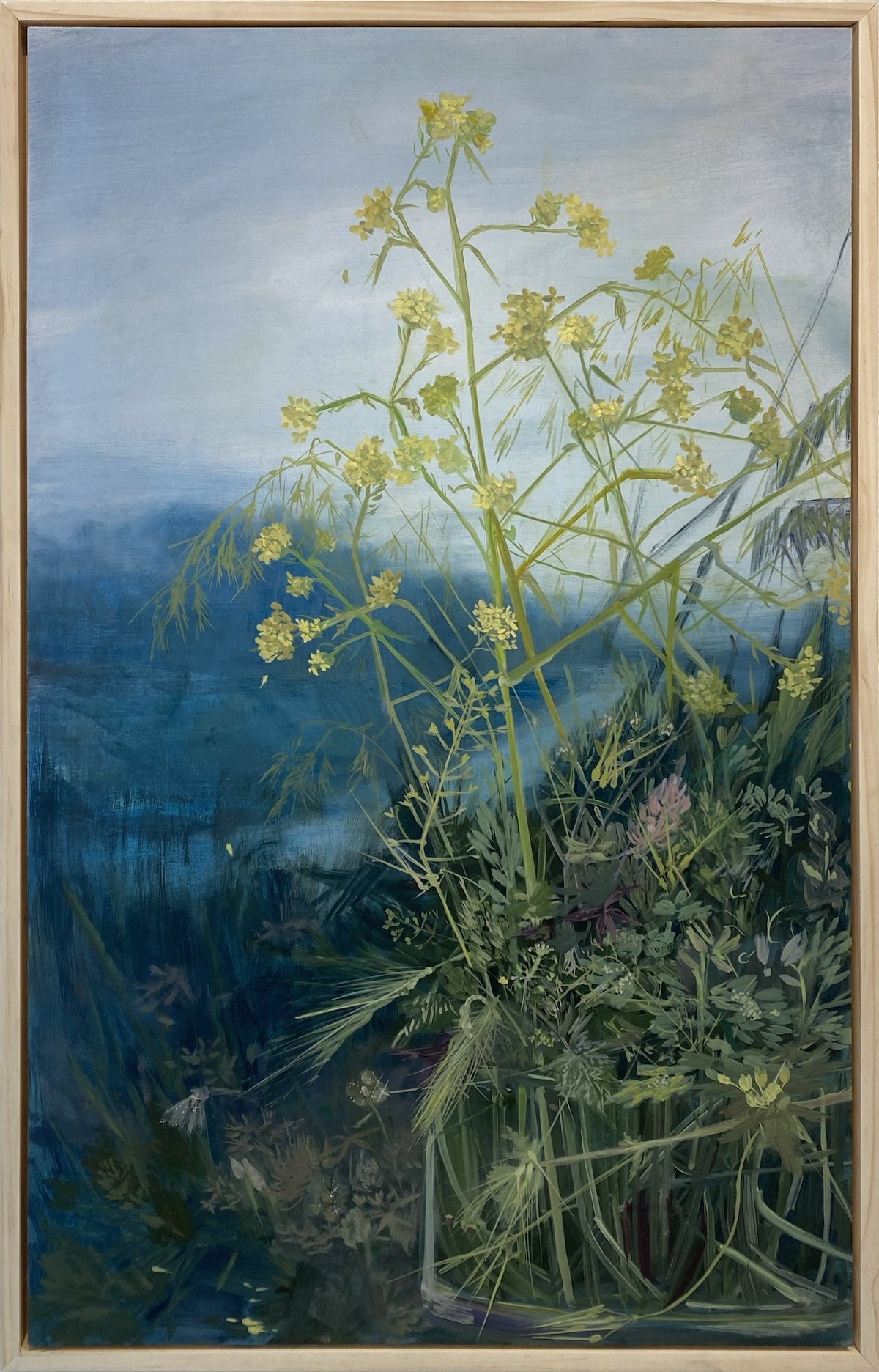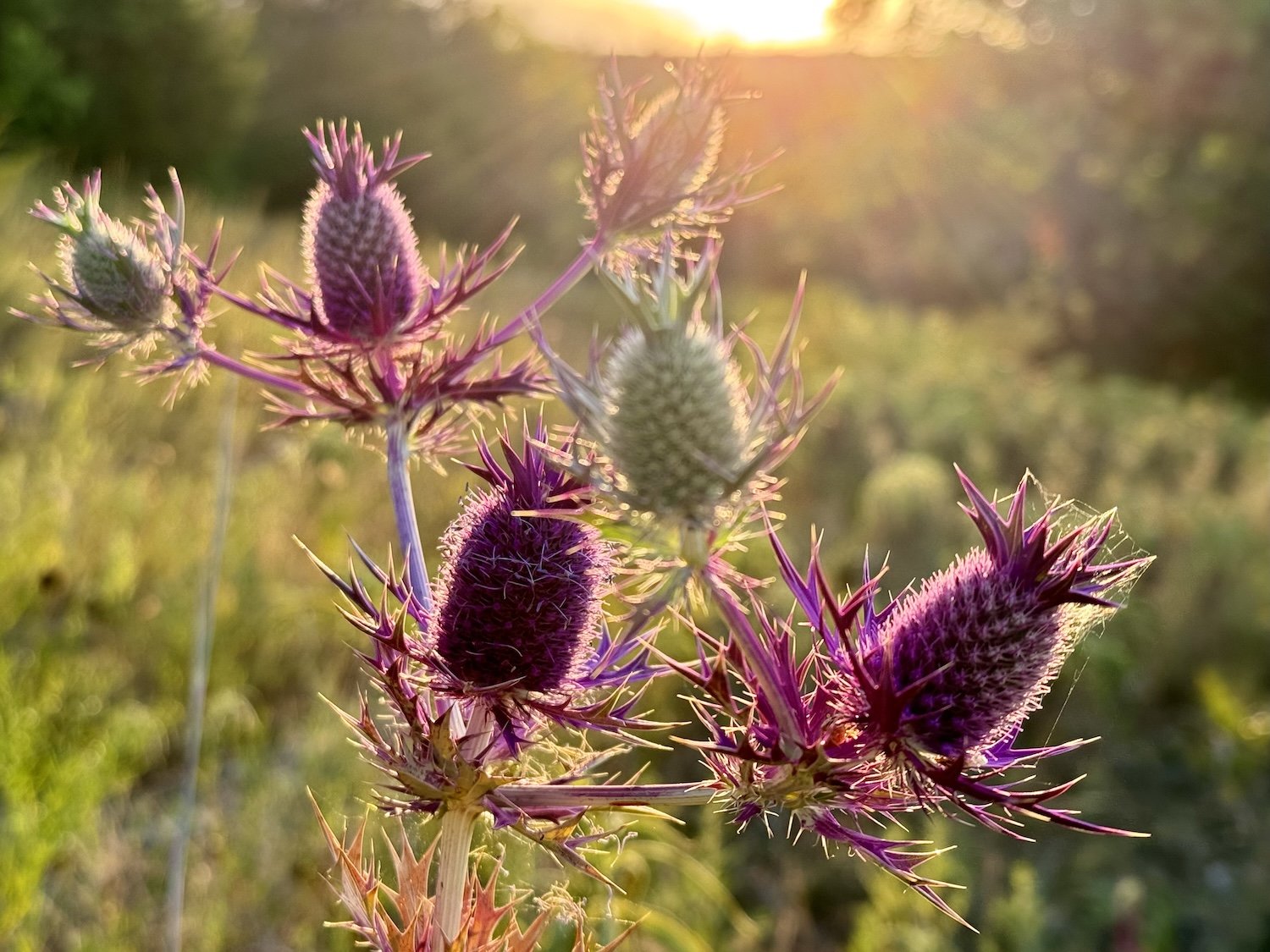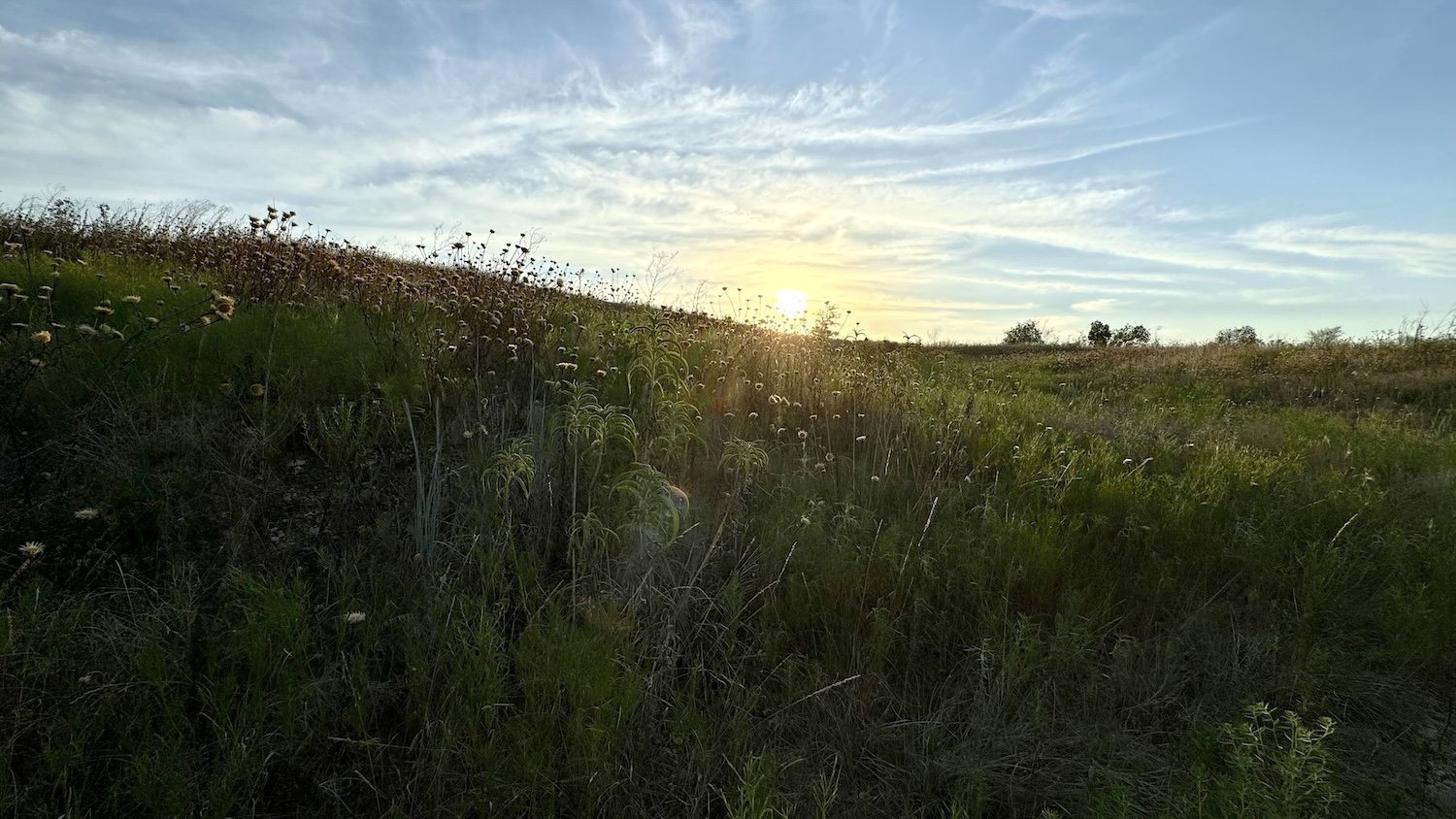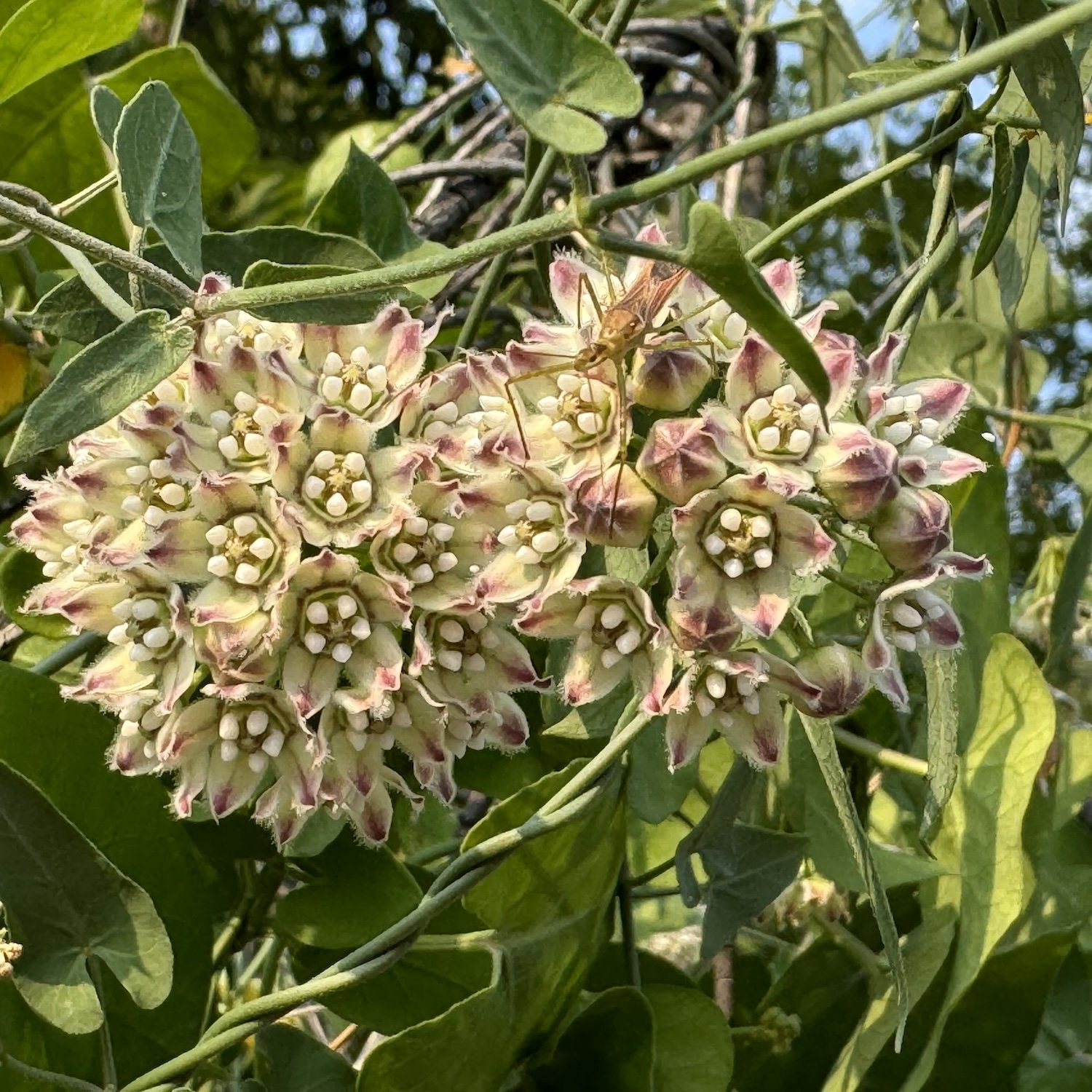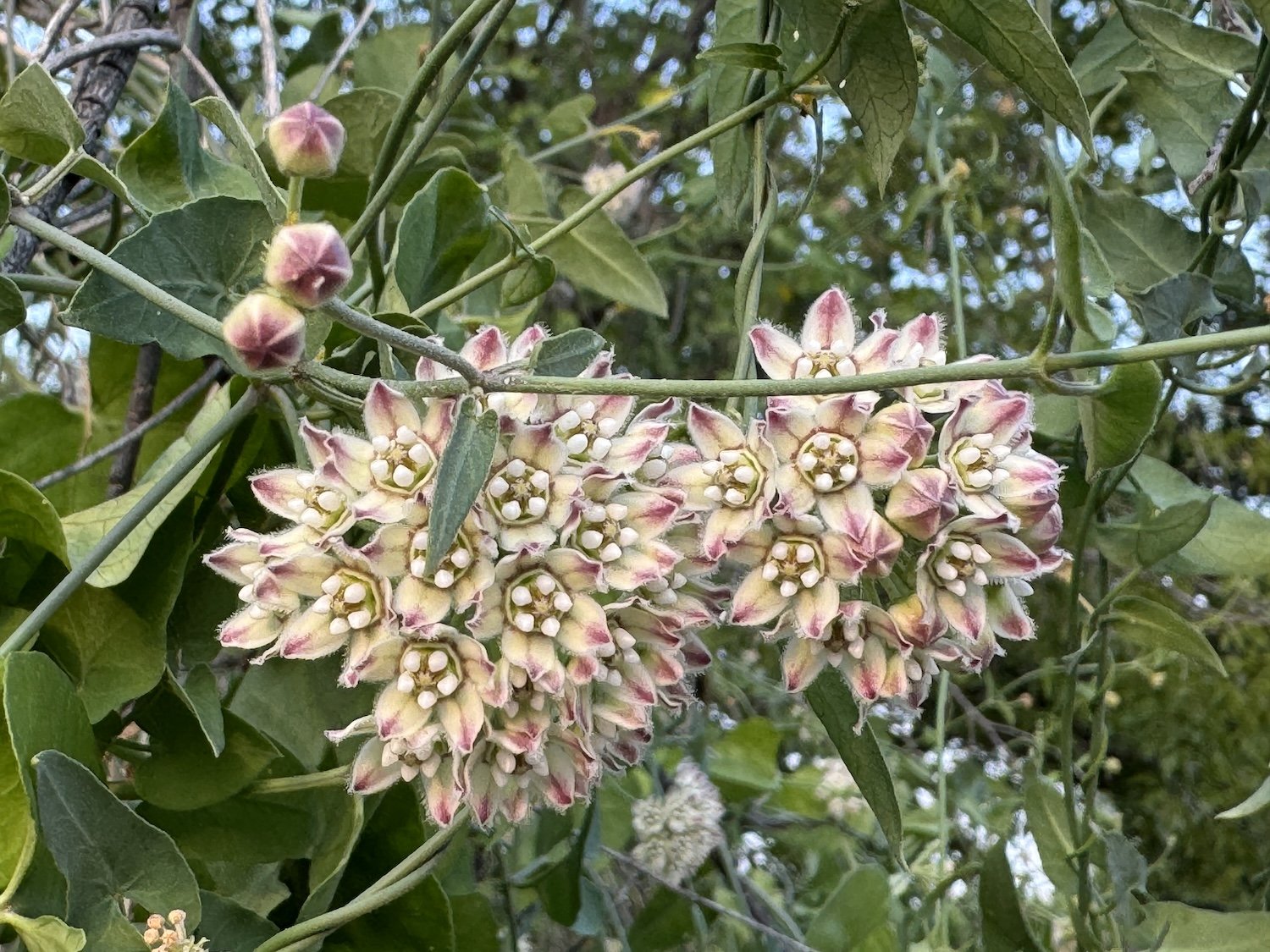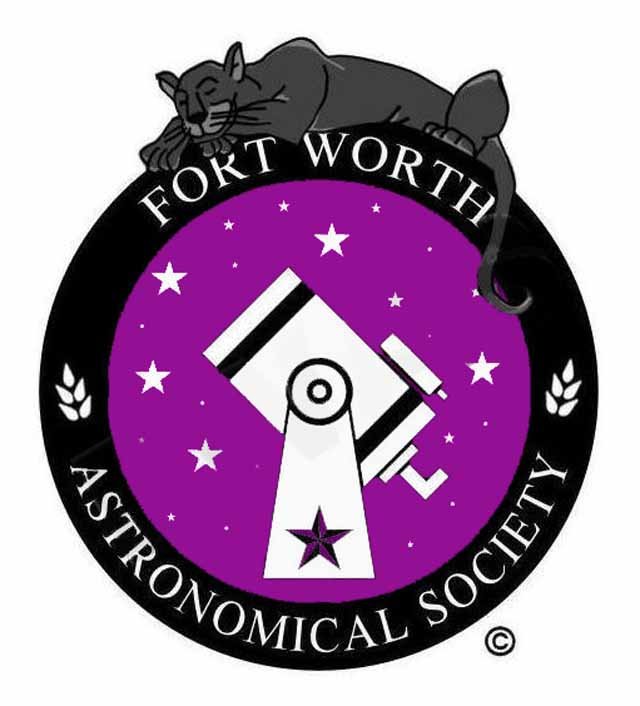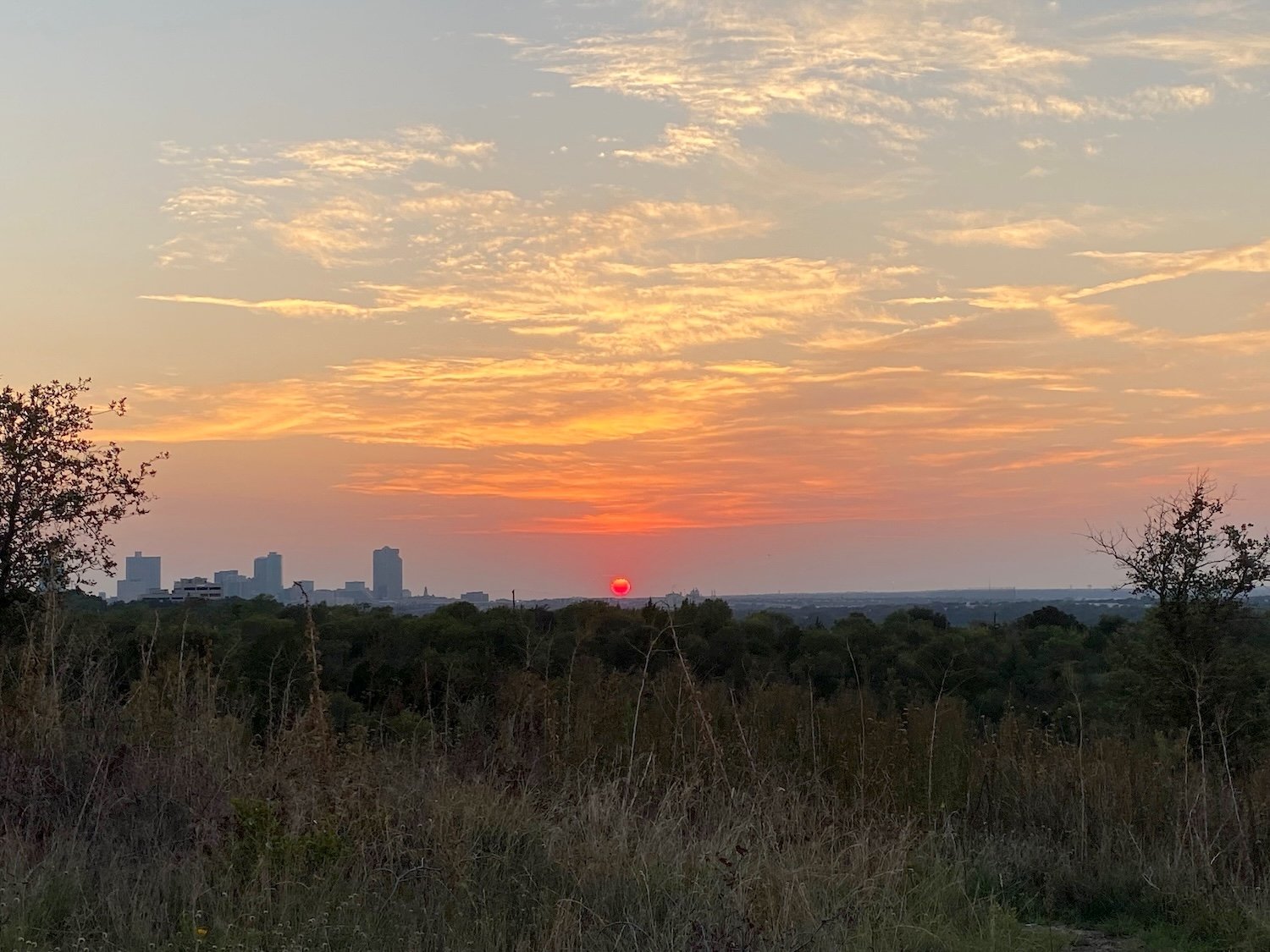Prairie Notes #213 - Drawn to the Light
Prairie Notes are monthly photo/journal observations from Tandy Hills Natural Area by Founder/Director, Don Young. They include field reports, flora and fauna sightings, and more, mixed with a scoop of dry humor and a bit of philosophy.
They are available free to all who get on the FOTHNA email list.
Drawn To the Light
Prairie Notes #213
September 1, 2024
1) Drawn To the Light
2) Prairie Artist of the Month - Erika Duque Scully
3) Field Report - August
4) New Species Report - August
5) Summer Surprise: Climbing Milkweed
6) PrairieSky / StarParty Report
7) Giving Day: 9.19.24
8) Other Voices - MIchael Smith
9) Prairie Proverb - Nina Simone
1) Drawn To the Light
The moth-ing event on August 10th, co-hosted with, Native Prairies Association of Texas, Texas Parks & Wildlife and Fort Worth Park & Recreation, was one our most successful events, ever. There were nearly as many people as wildlife species. The weather was not too bad, either.
Our leader, Sam Kieschnick, and the summer interns set up the eight viewing stations ahead of the event. A few members of the Cross Timbers Master Naturalists were also on had to help with ID’s. Adding to the fun were several members of the Fort Worth Astronomical Society whose telescopes pointed up at the night sky while we were busy looking down at white sheets. Here are the main stats of the event:
A diverse group of about 120 people attended including, some very smart and cute kids.
More than 80 NEW species were documented, and not just moths. (See a few notables in #4 below)
About 1,000 observations were made and more than 200 different species observed including:
66 Moth species
30 Beetles species
12 Fly species
11 Grasshopper species
8 Arachnid species (spiders & scorpions)
2 Cicada species
There were also stealthy visits by an Eastern Cottontail Rabbit, a Texas Spiny Lizard and an Eastern Screech Owl.
You may be wondering, “What exactly is “moth-ing” and why is it getting so popular?”
First of all, a more descriptive name for this activity is, black-lighting. (Some folks call it, “lightsheeting.”) Moths are just one of many insects drawn to lights. Most of us older folks recall seeing and hearing moths and other bugs flitting wildly around a porch light on a warm summer night. Due to environmental changes like habitat loss and wider use of lawn chemicals, such sights are less common today.
The basic process:
The first step is get the iNaturalist app so you can ID any insects you may find. Next step is to set up a light source behind a white sheet for moths and other flying insects to land on. The light source can be almost anything, although a blacklight or UV light works best. You will also need a headlamp or flashlight to focus on the insects while taking photos or to upload directly to iNat. Then you wait for darkness and see who shows up.
Here’s a brief history of how “Moth-ing” / “Black-lighting” got started and why it has taken off in north Texas.:
The idea of studying this phenomena probably began with an American entomologist named, William Brodbeck Herms. According to the Hitchcock Center website:
“In the early 1900s, entomologist William Brodbeck Herms tested insects’ attraction to different light wavelengths, and found that most were drawn to the blue-to-violet end of the visible spectrum. Subsequent work found that UV light (also called “black” light) was even more effective. That eventually led to bug zappers. These devices were marketed for decades as a means of controlling mosquitoes and other flying pests, until research showed that harmless or even beneficial species were being killed in greater numbers than pests.”
In 2009, a fellow from Massachusetts named, Dave Small, hosted his first “Moth Ball” in his backyard, making it an annual event for birders and other interested folks.
In 2012, National Moth Week was founded in East Brunswick, New Jersey. According to Sam Kieschnick, this helped spark the local, north Texas black-lighting scene which was already bustling with naturalists and citizen scientists. According to the NMW website:
“What began as a grassroots, local mothing event organized by Dave Moskowitz and Liti Haramaty in 2012, soon grew into an international citizen science initiative, inviting organizations and individuals worldwide to participate in documenting moth species across the globe.”
In 2015: Enter, Sam Kieschnick: While working at Oliver Nature Park in Mansfield, Texas, Sam was introduced to black-lighting by a man named, Chuck Sexton, who Sam invited to lead a black-lighting event there on July 17, 2015. As Sam told me, he was hooked. There is no doubt that Sam is the driving force behind black-lighting in north Texas and, probably, beyond. For the past six years, he has been doing around 70 black-lighting events a year, both public and private. It’s all his fault!!!
In 2016, at the Tandy Hills Bioblitz, Sam led the first of several black-lighting events at Tandy Hills.
As to the WHY of black-lighting, like all our events, past and present, it’s all about raising awareness of the natural world and the importance of protecting it. I like to recall a quote by Sam speaking about the iNaturalist website. I think it applies to black-lighting, as well:
“This is where the power, I think comes from — to get folks engaged with nature. That’s where I start seeing some meaningful changes in public policy and land management.”
Amen Brother Sam.
DY
> > > Click on photos to view them un-cropped. < < <
2) Prairie Artist of the Month - Erika Duque Scully
I first heard about Erika Duque Scully in April when she had an exhibit at, Fort Works Art Gallery, titled Posies. When I discovered she had visited Tandy Hills and had created works inspired by her visits here, I knew she was a perfect candidate for Prairie Artists of the Month. I think, she captures the atmospheric, almost other-worldly mystery of Tandy Hills.
But there is much more to her work than shown below as you can see in an upcoming exhibition at Fort Works titled, “Aether.” According to the Fort Works website: “In "Aether," Scully draws inspiration from the wildflowers and plants of North Texas, meticulously documenting her experiences in green spaces through sketches, field notes, and photographs.” The exhibit opens September 7th. Read more about that HERE.
Bio
I am a landscape and nature-based painter living and working in Fort Worth, TX. Next year will be 20 years since my family and I moved from New York City to Texas.
I am originally from Flushing, Queens, NY, and obtained my BFA in 2011 from The School of the Art Institute of Chicago, with an emphasis in drawing and painting, and an MFA in painting from Texas Christian University in 2018.
I have had an affinity for the arts from a very young age and was encouraged by my parents. Growing up in New York City, I had the opportunity to enroll in various arts programs offered by local museums and art institutions. As an adult, I now lead similar programs for people of all ages and backgrounds at local museums in the DFW and I now lead a monthly drawing class at Botanical Gardens in Fort Worth, TX.
Connection to THNA
One aspect of my artistic practice involves immersing myself in nature to draw, write, take photographs, and meditate. I aim to capture the essence of my natural experiences through my paintings and evoke a specific atmosphere within the landscape, often featuring a plant or flower as the central focus or protagonist. Lately, I have developed a keen interest in the native plants of Texas and their associated folklore. I enjoy crafting scenes that incorporate various flowers, each imbued with its symbolism, to weave together a cohesive narrative.
Tandy Hills holds a special place in my heart. I have created several paintings, photographs, and field notes inspired by this place. Geologically, it is very different from most of Fort Worth, which makes it a real treat to draw and paint. The rolling hills in the park are captivating, and as you venture further, you end up surrounded by these steep hills. What draws me to Tandy Hills time and time again is how the landscape changes throughout the seasons. Each season brings a new wave of native flowers that take over the landscape. Tandy Hills is an endless source of inspiration for me.
CLICK each image to view it un-cropped.
Tandy Hills, Acrylic on panel, 9” x 12”, 2017
Untitled (Detail of new painting), Oil on wood panel, 28” x 43”, 2024
3) Field Report - August
August was another broiler with zero rain until 8/28, when an unexpected shower dropped about 1/2” of rain. That helps the grasses which are the dominant feature of the fall prairie. You won’t find vast carpets of wildflowers in August but you will find a few shocking splashes of color here and there. And as you saw from the black-lighting event photos, the place is filled with wildlife.
CLICK each photo for best viewing.
A lucky photo of the buttermilk sky on August 20th, revealed a high-flying Dragonfly on closer inspection. (See #9 below.)
An inviting sunset view on a hot evening hike in late August. Basketflowers are fading and Maximilian Sunflowers about to bloom.
4) New Species Report - August
As detailed above, we had a gangbusters of a month with at least 82 new species in August, ending the month at 2,212. There were many notable species but I have posted a few of them below. You can check them all out on the Tandy Hills iNat Project Page HERE.
5) Summer Surprise: Climbing Milkweed
The last thing I expected to see at Tandy Hills on a blazing hot day in August was this exotic beauty: Climbing Milkweed (Funastrum cynanchoides). Also known as Fringed Twinevine, it was blooming a full 2 months later than last year, when I first discovered it. The perennial likes to climb other plants and fences. Insects of all kinds, including Monarch Butterflies, are attracted to and feed on it.
With skinny vines and small, arrow-shaped leaves, it’s rather plain-looking when not in bloom and easy to miss. The bloom period is only about two weeks. This is the only specimen I have seen at Tandy Hills and it’s growing about 4 feet from the street. It has the same milky-white sap and pungent odor of other milkweeds and the 8th milkweed species recorded at Tandy Hills, so far.
6) Prairie Sky / Star Party report
The August 10th, 2024 star party was reminiscent of our first time at Tandy Hills, back in 2016. Tandy Hills was hosting a “mothing” event conducted by a Texas Parks & Wildlife biologist as well as our FWAS Star Party. We had just gotten kicked out of the museum. The magazine “360 West” even did an article about us.
The star party results were very good for both of us this time, also. It was almost as productive as our old time at the Fort Worth Museum of Science and History. I was able to talk to the Urban Biologist, sam Kieschnick, and invite people attending his event to come by for a look through our telescopes and we would reciprocate by going over there.
- John McCrea, President, Fort Worth Astronomical Society
The next star party will be, Saturday, September 7th, 2024. Read the September sky-watching forecast from FWAS rep, John McCrea, below. View the full 2024 PrairieSky / StarParty schedule HERE.
“Our September 7th FWAS/Tandy Hills star party will continue our Summer Under the Stars with some of our favorite summer constellations plus some fall constellations. The center of our galaxy can be found in the constellation, Sagittarius (the Archer). Also, visible will be some of the well-known constellations such as: Scorpius (the Scorpion), Lyra (the Lyre), and Cygnus (the Swan). The remaining are Ursa Major, Cancer, and Hercules. Virgo will be setting, and Pegasus (the Winged Horse) and Pisces (the Fish) will be rising. The summer triangle (Vega (25 LY), Deneb (1,411 LY), and Altair (17 LY)) will still be visible.
The sun will set at about 7:45 PM on September 7th. The moon will be a 4 1/2-day old waxing crescent in the constellation Libra (The Scales). The “Lord of the Rings” of our solar system, Saturn (♄) will be in Aquarius (the water carrier), and will be up all evening, about 804 million miles away. Our telescopes will become time machines, and we will become time travelers, providing a look into the past as Saturn was, about 1 hour and 12 min. ago.
The autumnal equinox, on September 22nd, is when there is equal light on the Northern and Southern Hemisphere. It is also when the earth’s tilt causes the Northern Hemisphere to have less and less direct sunlight.”
7) Giving Day: 9.19.24
The official day is 9.19.24 but early donations begin on September 1st. The link to our official donation page is HERE:
If you prefer, you can always make a donation via Paypal at our website, HERE.
Here is a testimonial from Sam Kieschnick to help inspire your generosity:
“There is one word that I think of when I imagine Tandy Hills: Refuge. I seek out Tandy Hills as my refuge just as so many other urban organisms do. It’s one of the most precious and important places in Fort Worth. Nature is resilient, no doubt, but this refuge can be fragile --- it demands stewardship and protection by the dedicated folks of the Friends of Tandy Hills. From picking up trash, deterring off-trail photography, eliminating non-native species, and many other things, these are the individuals who prioritize the health and well-being of this refuge.”
Your generous donations are VITAL to our ongoing education and conservation efforts. Thanks a mil!
Don Young
08) Other Voices - Michael Smith
Local naturalist, herpetologist and author, Michael Smith and his friend, Kat, visited Tandy Hills in late August. Afterwards, he penned a lovely essay titled: Sunset in an Urban Oasis. Michael has a sensitive eye for the details that make Tandy Hills so special. His essay also reflects the title and subject of his recent book, Mindfulness In Texas Nature.
A mindfulness hike at Tandy Hills, one where you are fully present to yourself and your surroundings, can indeed be a restorative experience to mind, body and soul. Here’s an excerpt from the essay:
“Hardly anything allows a person to unwind and become content and restored like a walk at the end of the day in a place like this, with a friend like this. The shadows lengthened and the heat diminished, and there was always something wonderful to pull us around the next bend of the trail. However, our plan for the evening brought us back to the top of the ridge just at 8:10 PM as the orange disc of the sun touched the horizon. Having found a quiet place to sit, we wordlessly watched what unfolded.“
You can access the full essay on his website, Our Lives In Nature, HERE.
9) Prairie Proverb - Nina Simone
> Note: In 2024, all Prairie Proverbs will be from inspiring women.
“Dragonfly out in the sun, you know what I mean, don’t you know.
Butterflies all havin’ fun, you know what I mean.
Sleep in peace when day is done, that’s what I mean.
And this old world is a new world
And a bold world
For me.
And I’m feeling good
”
18th October 1964: Portrait of American pianist and jazz, folk, and gospel singer Nina Simone (1933 - 2003). (Photo by Hulton Archive/Getty Images)
Listen to, Feeling Good, with lyrics here: https://www.youtube.com/watch?v=CJA69C6SlRk
Become a member here: https://www.tandyhills.org/donate
Prairie Notes© is the official newsletter of Friends of Tandy Hills Natural Area, a 501 (c)(3) non-profit organization. All content by Don Young except where otherwise noted.



